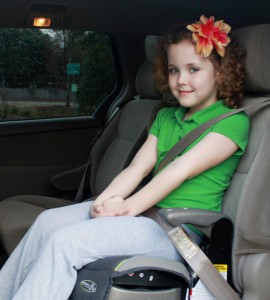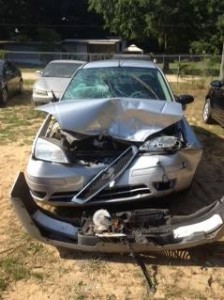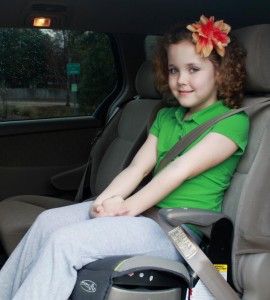by Ginny Hinton | Jan 30, 2015

There’s a new law in Florida – and although it’s far from comprehensive, it’s designed to better protect our kids. As of January 1, 2015, Florida law requires that all children riding in vehicles must use a safety seat until their 6th birthday. This means that kids who are 4- or 5-years-old and were previously restrained using just a seat belt must now ride in a car seat or booster seat.
Although much of the publicity about the new law also has reinforced the guideline that children under age 13 are much safer in the back seat, the law itself applies only to children who are not yet six. The law is not a “booster seat” law, because children under age 6 are still safer in a 5-point harness. Once your child is at least 4-years-old, weighs at least 40 pounds, and can sit in position for an entire car trip, you may make the decision to move that child to a booster seat. The fact remains, however, that the child is still much safer in a 5-point harness until he/she reaches the upper height or weight limit of that seat (typically 40-65 pounds). Even though your child may beg to differ, keeping him/her in a harnessed seat longer is one of the best gifts you can offer as a parent!
Want to make sure you’re using the best type of restraint for your child? You can find a nationally certified child passenger safety technician near you at http://cert.safekids.org. Click on “Find a Tech” and search by location.
by Ginny Hinton | May 12, 2014

New bill would require booster seats for children four years old through age five.
For several years, Florida has been the most dangerous state for children between the ages of 4 and 10 traveling in vehicles. Florida is currently one of only two states in the nation that lacks a booster seat bill for older children – and the only state that allows 4-year-olds to ride in an adult seatbelt.
Booster seats are needed for the simple reason that seat belts are designed to fit adults – specifically the “average” adult male. When a child under age 8 (on average) or under 4’ 9” tall and 80 pounds sits in an adult seatbelt, the lap belt tends to ride up onto his or her stomach. In a crash the belt tightens to keep the child from being ejected. It cuts through the soft stomach and the first bone to stop it is the spinal cord. This is known as “seat belt syndrome”. It can cause severe injuries including internal bleeding and even paralysis. A booster seat “boosts” the child up about six inches so the belt fits below the stomach and can restrain the child properly without causing injury. Using a booster seat reduces your child’s risk of injury by about 60%.
In Florida, some kids are about to get a safety “boost”. The Florida House and Senate just passed the revisions to Florida Statute 316.613 with Bill 225. If signed by Governor Scott, the new regulations will take effect on January 1, 2015. The new law will require children aged 4 through 5 years old to travel in a car seat or booster, NOT an adult seat belt. Unpaid drivers who are not in the child’s immediate family, children being transported for medical emergencies and children with a medical condition necessitating an exception are exempt from the law.
While this law by no means provides adequate protection for Florida’s older children, it is at least a step in the right direction. By a slim margin, Florida will no longer be the most unsafe state in the nation for child passengers.
by Ginny Hinton | Jun 5, 2013

The proper seat correctly installed helps keep children safe.
Dawson is a healthy, active 3-year-old whose mom makes sure he eats right, learns something new every day, and rides safely in the car. Until a few months ago, Dawson, who weighs 42 pounds and is 42 inches tall, traveled in a booster seat. When his mom learned that, because of his age, Dawson would be safer in a 5-point harness, she moved him to a safer car seat and made sure it was installed correctly. Just a few weeks ago, Dawson was riding in the car with relatives when someone drove in front of them and caused a 45 mph crash, totaling both cars. One of the adults fractured her collarbone; another suffered a concussion. Dawson bit his tongue and was really scared – but he was unhurt. Dawson’s mom says she is truly thankful she put him in the correct car seat. Because car seats are made to survive only one crash, she has already replaced his old seat and Dawson continues to travel safely in the car.
Dawson’s story can happen to any child. It’s important that every parent know how to keep their children safe on the roads. Here are some quick pointers to keep children safe at every age:
- All infants and toddlers should ride in a Rear-Facing Car Seat until they are 2 years old or until they reach the highest weight/height allowed by the manufacturer. Rear-facing is the safest way to travel!
- Children 2 years to at least 4 years old and 40 pounds should use a Forward-Facing Car Seat with a harness for as long as possible. Keeping a child who weighs more than 40 pounds in a harness is the safest practice, as long as the seat’s weight limits are followed.
- Children whose weight or height is above the forward-facing limit for their car seat should use a Belt-Positioning Booster Seat until the vehicle seat belt fits properly, typically when they are at least 4 feet 9 inches tall and are between 8 and 12 years old. Children using a booster seat should be able to sit reasonably still for an entire trip.
- Children who are old enough and large enough to use the vehicle seat belt alone should always use both Lap and Shoulder Belts for the best protection. Children younger than 13 years should sit in the back seat.
Certified Child Passenger Safety Technicians (CPSTs) are trained to help caregivers make sure their children are traveling safely. Find a CPST near you at http://cert.safekids.org.
by Ginny Hinton | Jul 6, 2012

A booster seat “boosts” a child up for proper placement of the lap and shoulder belt on the lower hips/upper thighs and shoulder/collar bone.
Piper is 7 years old. She goes to school, plays with dolls, and loves to visit friends. Piper’s career goal is to take over the world through “flower power”. When Piper travels, she sits in a booster seat that makes her seat belt fit perfectly. In a crash, Piper’s seat belt will keep her in the car and distribute crash forces across the strongest parts of her body. Piper’s mom makes sure she travels safely on every trip, so that Piper can confidently pursue her plans for world dominion.
Unfortunately, Piper and her mom are the exception. Many children in elementary school need to sit in booster seats but don’t. Following the law is not enough, especially for children in Florida. Only in Florida can a 4-year-old child legally use an adult seat belt.
In a crash, poor seat belt fit can lead to serious internal injury or even death. Children who have outgrown their 5 point harness car seat by weight or height should use a booster seat until they reach approximately 4’9”, typically between the ages of 8-12. Many parents/caregivers skip this very important step and start using a seat belt much too soon, never realizing the danger in which they’re putting their child.
A booster seat “boosts” a child up for proper placement of the lap and shoulder belt on the lower hips/upper thighs and shoulder/collar bone. Without a booster, seat belts often cross over a child’s soft stomach and neck, which can lead to debilitating injuries such as a ruptured spleen, torn intestines, internal bleeding, or paralysis.
Booster seats keep children out of the hospital, saving heartache, worry and medical expenses. A $15 booster seat for a child age 4-7 yields an average savings of $2,500 per child. “Big kids” like Piper deserve to be kept safe when they travel, and booster seats help make that happen. Is your child riding safely in the car?
For more information or assistance with child passenger safety please contact Ginny Hinton at the Santa Rosa County UF/IFAS Extension Office: ginnyh@santarosa.fl.gov or 850-623-3868.
(NHTSA & Partners for Child Passenger Safety (PCPS), **(Pacific Institute for Research and Evaluation (2010 update, ‘Injury Prevention: What works?’ Special Thanks to Tamyne Maxson, Child Passenger Safety Community Coordinator, St. Joseph’s Child Advocacy Center, Tampa, FL




